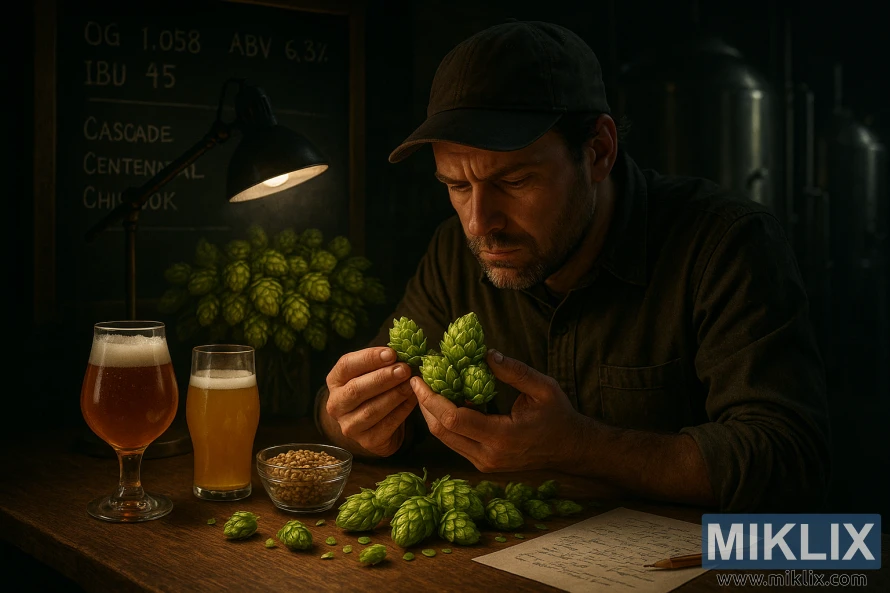Image: Brewer Examining Hops
Published: August 30, 2025 at 8:56:23 AM UTC
Last updated: September 26, 2025 at 9:25:21 PM UTC
A brewer studies fresh hop cones in a dimly lit brewhouse, surrounded by glassware, malts, and notes, reflecting focus on recipe development.
The scene captures a moment of quiet intensity, where the art and science of brewing converge in the figure of a brewer lost in deep concentration. He sits at a sturdy wooden table, its surface scattered with the essential tools of his craft: gleaming hop cones arranged in small piles, a shallow bowl filled with pale malt grains, and a sheet of paper covered with hastily written recipe notes. His posture is forward-leaning, his hands carefully cradling a pair of vibrant green hop cones, turning them over with the precision of someone who understands that even the smallest details—an aroma, a texture, the density of the bracts—could determine the character of the final beer. The light above him, a simple industrial lamp, casts a warm, golden glow, illuminating the intricate patterns of the hops while leaving much of the surrounding brewhouse in shadow. The effect is almost theatrical, as though the brewer and his hops were actors on a stage, the rest of the world fading away in the background.
To his left, two glasses of beer provide a tangible reminder of the journey these hops are destined for. One is a hazy golden brew with a frothy white head, its cloudy opacity suggesting a modern, hop-saturated style such as a New England IPA. The other is a deeper amber, clearer and more refined, topped with a cream-colored foam that speaks to a more traditional recipe, perhaps a pale ale or IPA brewed with a balanced malt backbone. Together, the two glasses represent both the history and the evolution of hop-forward brewing, with Cascade, Centennial, and Chinook—the varieties listed on the chalkboard in the middle ground—serving as the common thread linking past to present. Their flavors, spanning floral, citrus, pine, and spice, offer the brewer a palette as broad and nuanced as that of a painter facing a blank canvas.
The chalkboard itself is both functional and symbolic. Written in crisp white chalk are brewing specifications: OG 1.058, ABV 6.3%, IBU 45. To the uninitiated, these numbers might seem cryptic, but to the brewer they are vital signposts, marking the boundaries within which his creativity can unfold. Original Gravity (OG) defines the starting density of sugars, Alcohol by Volume (ABV) speaks to the strength of the finished beer, and International Bitterness Units (IBU) quantify the sharpness of hop bitterness. Together with the hop varieties listed beneath, they sketch the skeleton of a recipe waiting to be fleshed out. This is the brewer’s canvas, and the hops he examines so carefully are the brushstrokes that will bring it to life.
In the background, large stainless steel fermentation tanks rise into the shadows, their polished surfaces catching only faint reflections of the lamplight. They stand like silent sentinels, reminders of the industrial precision that underpins the brewer’s artistry. Their presence is imposing yet distant, allowing the focus to remain firmly on the intimate act of selection and contemplation taking place in the foreground. The contrast between the human scale of the brewer at his table and the massive machinery looming in the dark underscores the dual nature of brewing: at once personal and mechanical, tactile and technological.
The atmosphere of the image is suffused with concentration and reverence. The brewer’s furrowed brow and the way he narrows his gaze at the hop cones suggest a man caught between intuition and calculation. He is not merely following a formula but feeling his way toward balance, guided by years of experience and a deep respect for his ingredients. The handwritten recipe notes nearby add a human touch, a reminder that even in an age of digital precision, brewing remains an art rooted in observation, memory, and experimentation. Every batch carries with it the possibility of surprise, and every adjustment—adding more Centennial for floral brightness, dialing back the Chinook to soften its pine bite—could push the beer closer to perfection.
What emerges from this scene is not just the portrait of a brewer at work, but of brewing itself as an act of devotion. The hops, glowing in their green vibrancy, embody the potential for flavor and aroma that has inspired generations of brewers. The beers on the table, one hazy and modern, the other clear and classic, embody the past and future of the craft. And the man, leaning into the light, lost in thought over a handful of cones, embodies the timeless pursuit of excellence, where passion and precision unite to transform humble plants into something greater than the sum of their parts.
The image is related to: Hops in Beer Brewing: Atlas

